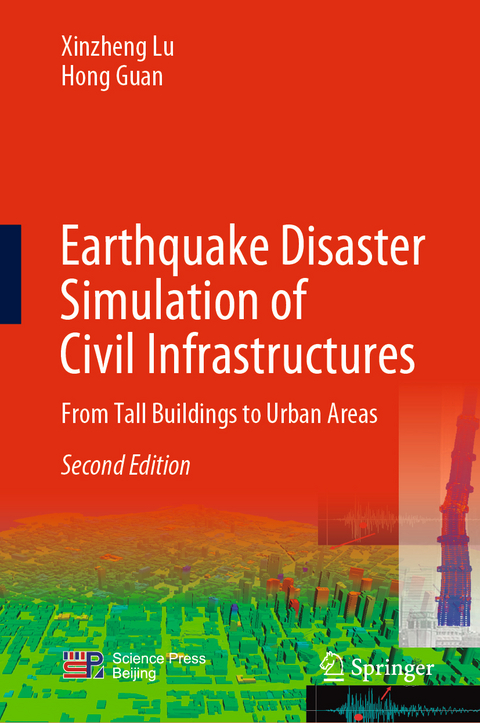
Earthquake Disaster Simulation of Civil Infrastructures
Springer Verlag, Singapore
978-981-15-9531-8 (ISBN)
Prof. Xinzheng Lu obtained his BS and PhD degrees from Tsinghua University of China. He started his academic career in 2005 as an Assistant Professor at the same university. He was subsequently promoted to Associate Professor in December 2007, Head of the Institute of Disaster Prevention and Mitigation in 2010 and Full Professor in December 2012. His major research interests cover disaster prevention and mitigation of civil engineering structures. He participated in the emergency earthquake reconnaissance and structural retrofitting after Wenchuan (2008), Yushu (2010), Lushan (2013), Ludian (2014) and Nepal earthquakes (2015). Prof. Lu has published more than 200 papers in refereed journals and 13 books. His publications have received more than 1600 citations in Web of Science. Nine of his publications were listed by InCites database as “Top 3% Most Cited Papers” of the WOS subject areas. His publications have been widely cited by many scholars with astrong international reputation, including more than 40 fellows/members of NAS/NAE of USA, RAE of UK, etc. A book review on Engineering Structures regards his book as “the latest and most advanced methods for the study of tall buildings and urban areas during earth tremors.” He has been listed as the “Chinese most cited researchers from 2014-2019” Prof. Lu has received several important awards including: the Distinguished Professor of Chang Jiang Scholars Program of Ministry of Education of China (2018), the Leading Researcher of “Ten Thousand Talent Program” of China (2016), the Young Scholarship of Chang Jiang Scholars Program of Ministry of Education of China (2015), the Early-Mid-Career Research Leader Program of the Promotion Plan of Innovative Talent of Ministry of Science and Technology of China (2013), the National Natural Science Award (Second Prize, 2013), the Excellent Young Scientist Fund of National Natural Science Foundation of China (2012) andthe National Outstanding Doctoral Thesis Notification (2007). Prof. Hong Guan obtained her double BEng degrees in Civil Engineering and Computer Engineering from Tsinghua University, China, her MEng degree in Structural Engineering from the Asian Institute of Technology, and her PhD degree from Griffith University, Australia. She is a professor in Structural Engineering and Mechanics at Griffith University Gold Coast Campus. Her main research areas are progressive collapse mechanisms of frame and flat plate structures, finite element analysis and modelling, failure analysis of planar continuum structures with and without openings, cracking and punching shear failure analyses in flat slab systems, bridge deterioration modelling and intelligent system for Level-2 bridge condition inspections, application of finite element method in dental implant research, topology optimisation of structures. She has co-authored one edited conference proceedings, and published over 130 peer-reviewed journal articles and over 150 refereed conference papers. Her publications have received more than 600 citations in Scopus. She has received numerous teaching awards including ALTC Citations for Outstanding Contributions to Student Learning from the Australian Learning & Teaching Council. She also received a Entry in “Australian Chinese Professionals and Entrepreneur Who's Who” from Ausinan Science and Technology Society, Australia (2018), “2011 Excellence Award for Innovation” from the Institute of Public Works Engineering Australia, Queensland Division (IPWEAQ), National Awards for Local Governments with a Commendation in the Category of Asset and Financial Management (2012), and Griffith Science, Engineering, Environment & Technology Pro Vice Chancellor’s Excellence Award of a Research Group (2012). She is a member of East-Asia Pacific Conference on Structural Engineering and Construction (EASEC) International Steering Committee, Engineers Australia, Australian Network on Structural Health Monitoring, Australian Association for Engineering Education, Queensland Chinese Association of Scientists and Engineers, Australian Steel Institute, and Women in Technology, Queensland, Australia.
Introduction.- High fidelity Computational Models for Earthquake Disaster Simulation of Tall Buildings.-Earthquake Disaster Simulation of Typical Supertall Buildings.- Comparison of Seismic Design and Resilience of Tall Buildings based on Chinese and US Design Codes.- Simplified Models for Earthquake Disaster Simulation of Supertall Buildings.- Seismic Resilient Outriggers and Multi-hazard Resilient Frames.- Building Models for City-scale Nonlinear Time-history Analyses.- Regional Seismic Loss Estimation of Buildings.- Visualization and High-performance Computing for City-scale Nonlinear Time-history Analyses.- Fire Following Earthquake and Falling Debris Hazards.- Emergency Response and Post-earthquake Recovery using City-scale Nonlinear Time-history Analysis.- Earthquake Disaster Simulation of Typical Urban Areas.- Conclusions.
| Erscheinungsdatum | 05.02.2021 |
|---|---|
| Zusatzinfo | 644 Illustrations, color; 145 Illustrations, black and white; XXVI, 934 p. 789 illus., 644 illus. in color. |
| Verlagsort | Singapore |
| Sprache | englisch |
| Maße | 155 x 235 mm |
| Themenwelt | Naturwissenschaften ► Biologie ► Ökologie / Naturschutz |
| Technik ► Bauwesen | |
| Schlagworte | Collapse Simulation • High-fidelity Visualization • Performance-based Seismic Design • Post-earthquake Response • Resilience of Buildings and Communities • Seismic Damage Simulation • Tall and Supertall Buildings |
| ISBN-10 | 981-15-9531-3 / 9811595313 |
| ISBN-13 | 978-981-15-9531-8 / 9789811595318 |
| Zustand | Neuware |
| Haben Sie eine Frage zum Produkt? |
aus dem Bereich


